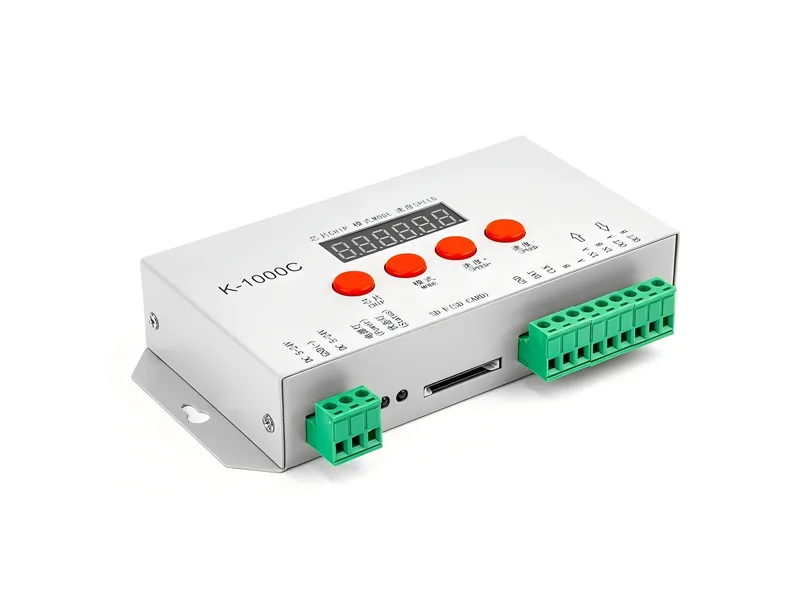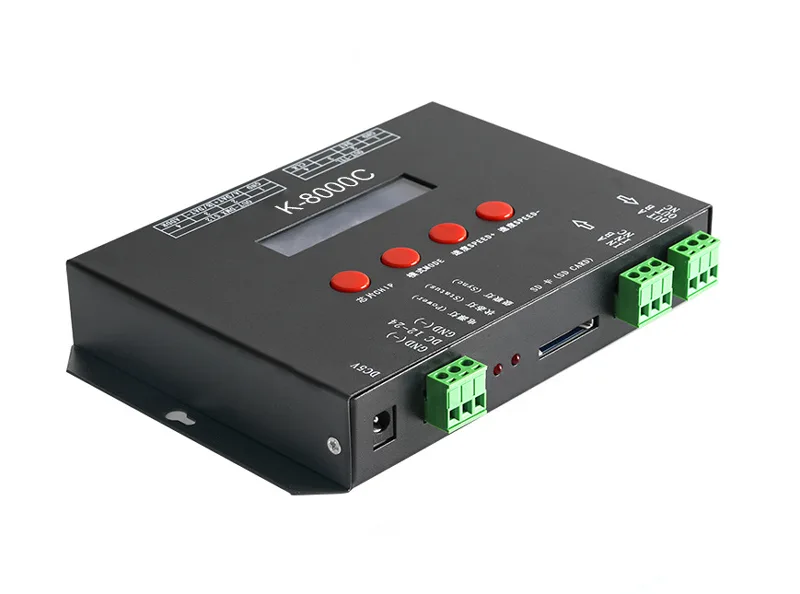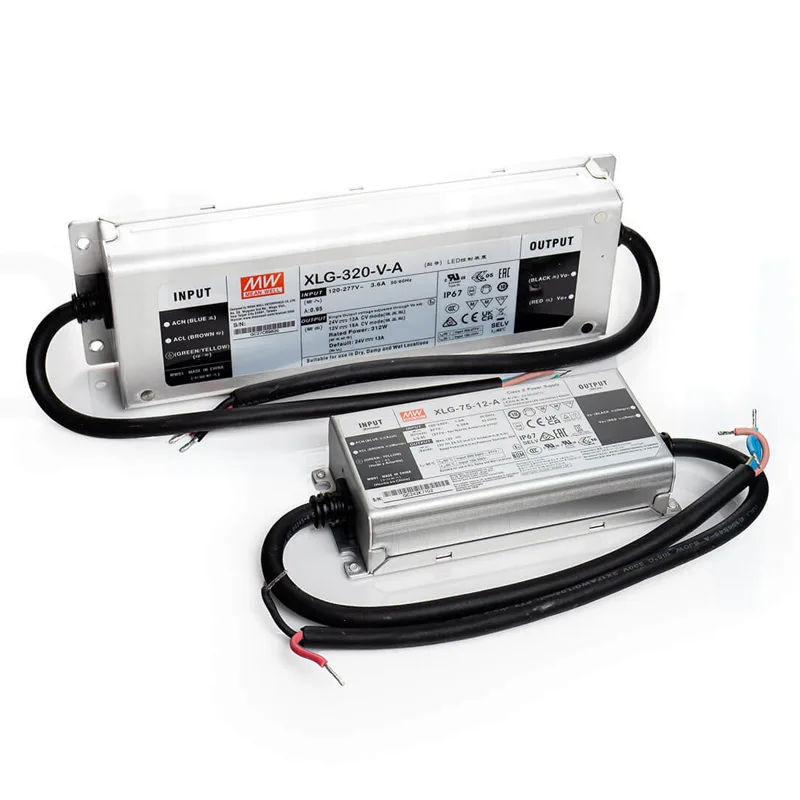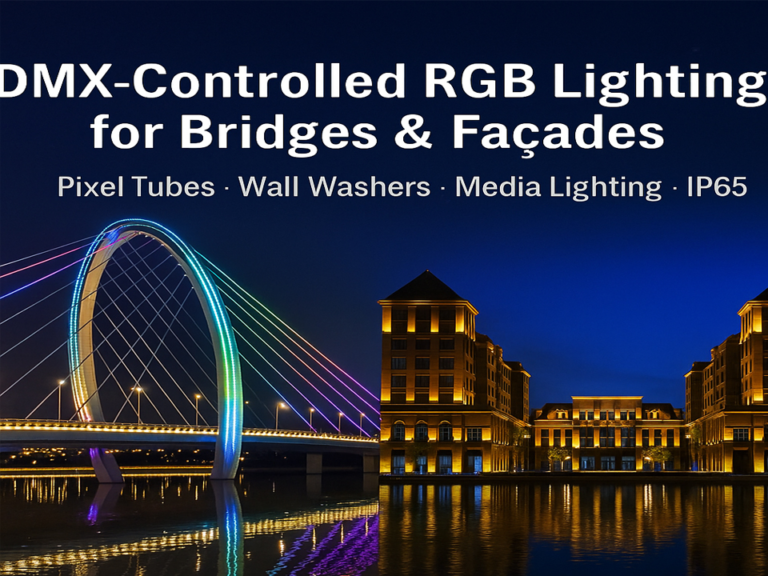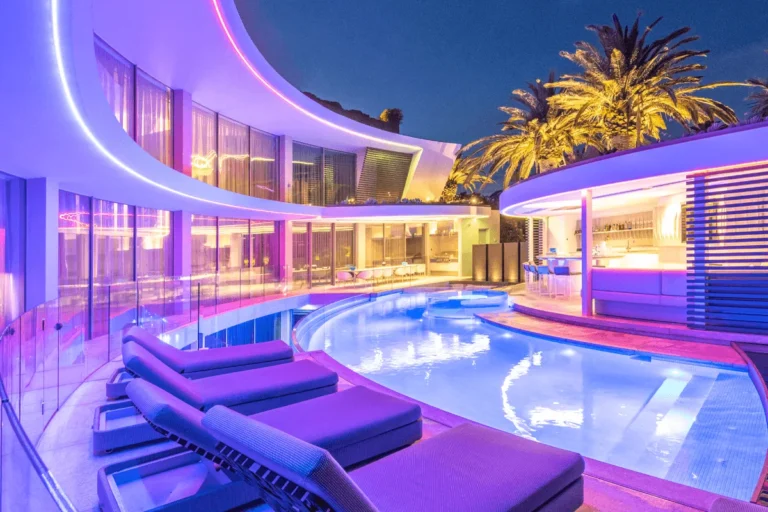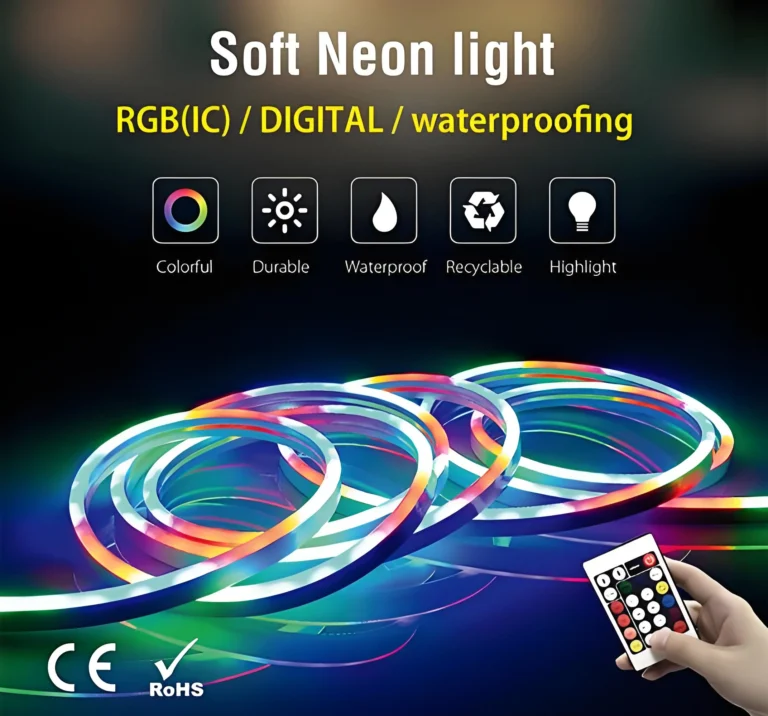새로운 세대의 LED 건축 조명이 등장하고 있습니다: LED 네온 플렉스는 건물 외관에 완벽하게 맞고 기존 네온보다 에너지 소비량이 85% 적으며 DMX512 지능형 제어 시스템을 통해 단일 건물에서 256만 가지 색상 조합을 구현할 수 있습니다.
상하이 센터 타워의 나선형 조명 효과와 광저우 타워의 픽셀화된 조명 쇼는 디지털 조명의 무한한 가능성을 확인시켜 줍니다. 더욱 주목할 만한 것은 심천 핑안 빌딩의 조명 시스템이 실시간으로 PM2.5 데이터에 반응하고 빛과 그림자로 도시의 공기질을 시각화할 수 있는 IOT 기술을 통합한 것입니다. 지능형 조명은 건물 외관을 디지털 캔버스로 바꾸어 휴일 축하 행사나 공익 캠페인과 같은 장면을 매끄럽게 전환하도록 프로그래밍할 수 있습니다. 밀라노의 수직 숲의 조명은 나무의 광합성 리듬을 모방하여 건물을 살아있는 유기체로 만들어 줍니다.
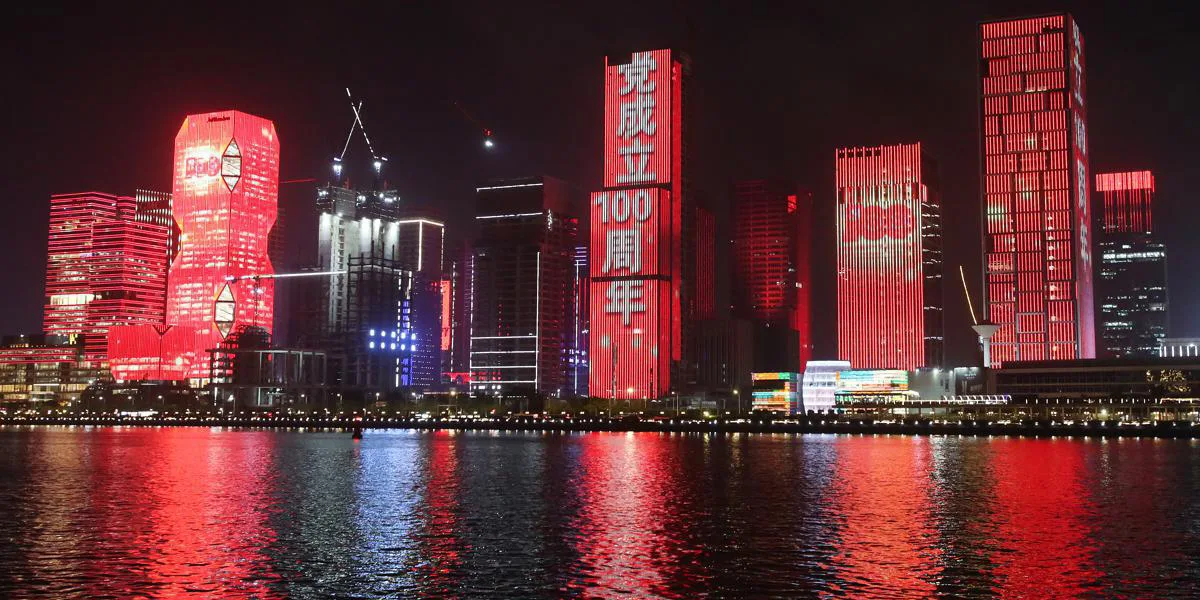
건축 조명 디자인에서 DMX 제어 LED 네온 플렉스는 뛰어난 유연성과 역동적인 표현력으로 공간의 미학을 재구성하고 있습니다. 디자이너는 DMX512 프로토콜을 통해 각 스트립의 밝기, 색상, 다이내믹을 정밀하게 조절할 수 있어 점진적인 호흡부터 복잡한 리듬까지 무한한 창의력을 발휘할 수 있습니다. 이 기술 가이드에서는 DMX 조명 시스템 아키텍처, 디자인 포인트, 기존 장비의 제품 선택에 대해 분석합니다. 프로젝트의 빠른 구현에 도움이 되길 바랍니다.
지능형 조명에서 DMX512 프로토콜의 장점
DMX512 프로토콜은 512개의 독립 채널을 통해 조명별 제어를 구현하여 색상, 밝기, 동적 효과 등 다차원 파라미터를 정확하게 구동할 수 있어 무대나 건물 정면과 같은 장면에서 복잡한 조명 효과의 엄격한 요구 사항을 충족할 수 있습니다.
밀리초의 응답 속도로 대규모 램프와 랜턴의 동기화된 작동을 보장하며, 특히 동적 조명 추적 및 음악 연동과 같은 실시간 인터랙티브 애플리케이션에 적합합니다. 마스터-슬레이브 아키텍처와 차동 시그널링을 채택하여 최대 32개의 디바이스와 수천 개의 노드를 직렬로 지원하므로 시스템 확장성이 뛰어납니다.
표준화된 인터페이스와 강력한 호환성으로 조광기, 컨트롤러 및 다양한 유형의 지능형 램프에 원활하게 액세스할 수 있으며, RS485 물리 계층 전파 방해 방지 특성과 결합하여 프로젝트의 복잡한 전자기 환경에서도 안정적인 전송을 유지할 수 있습니다.
이러한 기술적 특성으로 인해 DMX는 대규모 공연, 테마 경관, 건물 외관 및 기타 전문 조명 분야에서 선호되는 제어 솔루션입니다.
건축 조명에 LED 네온 플렉스를 사용하는 이유는 무엇인가요?

사용 건축 조명용 LED 플렉시블 네온 스트립 에는 여러 가지 장점이 있습니다. 우선, 유연성이 뛰어나 복잡한 곡면이나 모양의 구조물에 적합하고 건물 윤곽, 파사드 장식, 돔 서라운드 및 기타 창의적인 디자인을 쉽게 구현하여 조명 예술에 더 강력한 표현력을 부여할 수 있습니다.
네온 라이트 스트립은 모듈식 디자인을 채택하여 다양한 크기의 설치 시나리오에 맞게 자유롭게 자르고 연결할 수 있어 시공의 어려움을 크게 줄여줍니다.
둘째, LED 광원은 지능형 디밍 시스템, 기존 조명에 비해 에너지 효율이 50% 이상 향상되고 열 발생이 적어 건물의 열 부하를 줄이는 등 높은 발광 효율과 낮은 에너지 소비 특성을 가지고 있습니다.
셋째, RGB 풀컬러 조명 믹싱과 동적 프로그래밍을 지원하고 DMX 또는 무선 프로토콜을 통해 컬러 그라데이션, 러닝라이트, 음악 연동 및 기타 효과를 구현하여 건축 야경의 상호작용성과 기술적 감각을 향상시킵니다.
또한 플렉시블 스트립의 외부 레이어는 실리콘 또는 에폭시 수지로 캡슐화되어 최대 IP67 이상의 방수 등급, 강력한 내후성, 실외 온도차, 비, 자외선 환경에 대한 적응성, 최대 50,000시간의 서비스 수명으로 유지보수 비용을 크게 절감할 수 있습니다. 또한 저전압 전원 공급(12/24V) 특성으로 전기 안전성이 향상되어 현대 건축 조명 프로젝트에 선호되는 솔루션입니다.
DMX512 시스템이란 무엇인가요?
DMX512(디지털 멀티플렉스 512)는 무대 조명, 건축 조명 등의 분야에서 널리 사용되는 디지털 제어 프로토콜 표준입니다. 디지털화된 신호를 통해 조명기구의 정밀한 제어를 실현합니다. 핵심 원리는 직렬 통신으로 제어 명령을 전송하는 것이며, 각 DMX 신호 링크는 마스터 컨트롤러(예: 디머 콘솔)와 여러 슬레이브 장치(조명기구, 디머 등)로 구성됩니다. 이 시스템은 차동 신호 전송 기술을 사용하는 RS-485 물리 계층 표준을 기반으로 하며, 강력한 전파 방해 방지 기능과 최대 1200미터의 전송 거리(리피터 확장 필요)를 제공합니다.
각 DMX 데이터 프레임에는 512개의 독립적인 제어 채널이 있으며, 각 채널은 8비트 데이터(값 범위 0~255)에 해당하여 램프의 밝기, 색상, 모션 트랙 및 기타 파라미터를 조정할 수 있습니다. 예를 들어 RGB LED 조명기구는 일반적으로 3개의 채널(빨간색, 녹색, 파란색 각각 1개 채널)을 사용하며 주소 인코더를 통해 시작 채널 번호를 설정한 후 해당 명령을 수신할 수 있습니다. 컨트롤러는 조명 변경을 실시간으로 동기화하기 위해 초당 약 44회 새로 고침하면서 최대 250kbps의 속도로 데이터 패킷을 주기적으로 전송합니다. 이 시스템은 연쇄 직렬 구조를 지원하여 단일 회선으로 최대 32개의 장치를 제어할 수 있으며, 스플리터를 통해 수천 개의 노드로 확장하여 대규모 조명 프로젝트의 요구 사항을 충족할 수 있습니다.
DMX512 시스템 구성은 주로 다음과 같은 부분으로 구성됩니다:
DMX 콘솔제어 신호를 보내는 주요 장치(예: 조명 콘솔 또는 소프트웨어).
DMX 수신기픽스처 또는 기타 장비의 디코딩 모듈로, 명령을 수신하고 실행합니다.
DMX 케이블: 특수 차폐 트위스트 페어 케이블, 5핀 또는 3핀 XLR 커넥터와 연결.
종단 저항기: 신호 반사 간섭을 방지하기 위해 신호 체인 끝에 저항기(보통 120Ω)가 설치되어 있습니다.
DMX512 네온 테이프의 특징은 무엇인가요?
- DMX 픽셀 네온 스트립은 독립적으로 제어되는 여러 개의 LED 비드(픽셀)로 구성됩니다. 각 픽셀은 색상(예: RGB/RGBW)과 밝기를 개별적으로 조정하여 동적 패턴이나 그라데이션 효과를 만들 수 있습니다. 각 LED를 독립적으로 프로그래밍하여 섬세한 애니메이션 효과(예: 흐르는 물, 깜박임, 페이드)를 구현할 수 있습니다.
- 기존 네온 조명에 비해 에너지 효율이 높고 내구성이 뛰어나며 프로그래밍 제어를 지원합니다.
- 유연한 소재(예: 실리콘, PVC)로 감싼 LED 네온 스트립은 복잡한 모양(예: 곡면, 곡선 구조물)의 설치 환경에 맞게 자유롭게 구부리고 자를 수 있습니다.
- 장거리 전송(최대 1200미터), 높은 호환성, 여러 장치를 동시에 제어할 수 있습니다.
- 텍스트, 패턴, 움직이는 이미지에 적합한 고해상도 디스플레이를 지원합니다.
- 무빙 헤드 라이트, 레이저 조명 등 다른 무대 조명 장비와 동기화하여 통일된 효과를 낼 수 있는 DMX 컨트롤러를 통해 명령을 전송할 수 있습니다.
- 대규모 설치(예: 건물 외관, 대형 무대)의 요구 사항을 충족하기 위해 다중 유니버스 확장을 지원합니다.
- 일반적으로 최대 IP65 또는 IP67의 높은 방수 등급으로 열악한 실외 환경도 걱정할 필요가 없으며 실내 및 실외 사용에 적합합니다.
- 절단 가능한 디자인: 필요에 따라 길이를 조정하여 설치의 복잡성을 줄입니다.
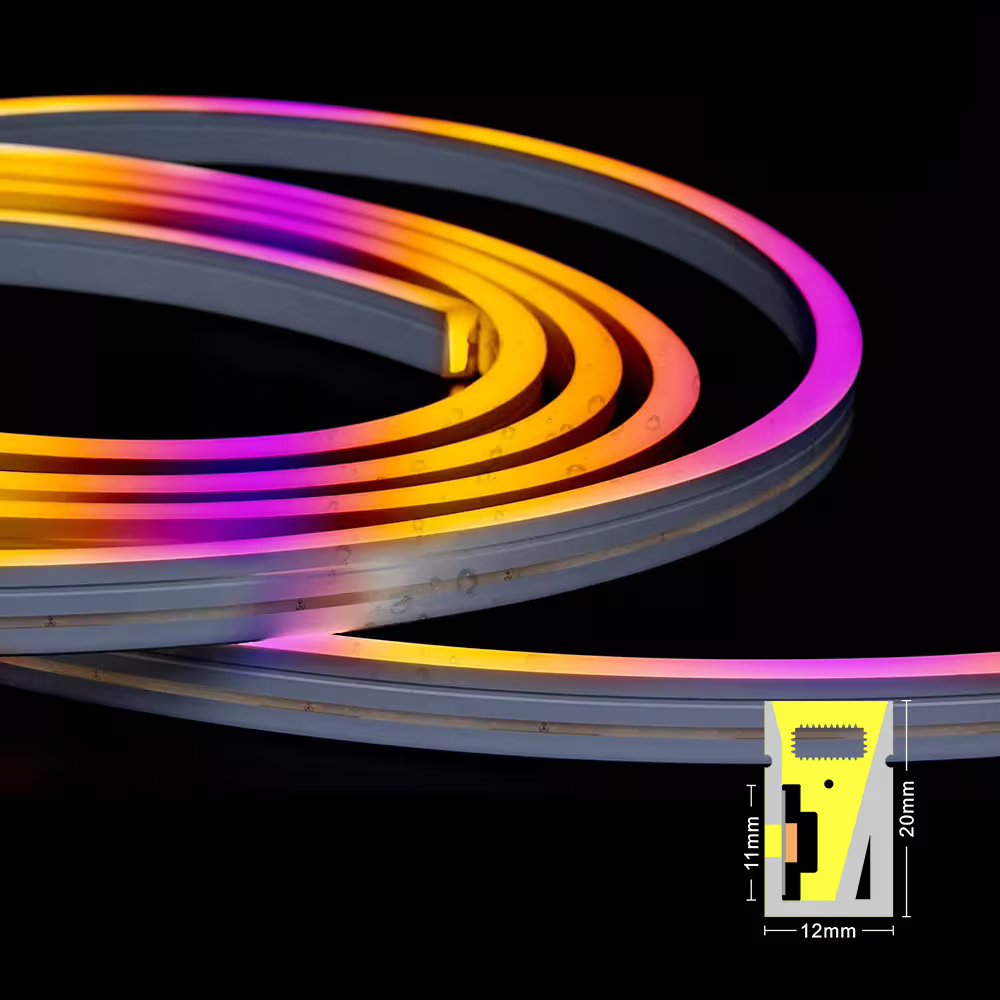
건축, 벽면 글레이저 및 외관 조명용 사이드 벤드 S1220 실리콘 주소 지정 가능 LED 네온 스트립
입력 전압: DC24V
와트: 12W/m@RGB, 19W/m@RGBW
LED 수량: SMD5050 60LED/m
색온도: RGB/RGBW(2700K-6500K)
신호 유형: SPI/DMX512
IP 등급: IP65/IP67
케이블 입력: 전면
최소 굽힘 직경: 100mm
절단 가능한 길이: 100mm
길이: 5미터/롤
DMX512는 LED 네온 스트립을 어떻게 제어하나요?
DMX512 컨트롤러는 디지털 신호(RS-485 표준에 따라)를 통해 LED 네온 스트립 시스템에 명령을 전송하고, 디코더가 신호를 파싱한 다음 사전 설정된 주소에 따라 각 LED 픽셀의 RGB 채널 데이터를 일치시켜 밝기(0-255 레벨)와 컬러를 독립적으로 조정합니다. 사전 설정 장면 프로그래밍 또는 실시간 제어를 통해 동적 그라데이션, 동기화된 깜박임 및 무대, 건물 및 기타 장면에 적용할 수 있는 기타 효과를 달성하여 여러 장치가 함께 작동하고 간섭을 방지할 수 있으며, 구체적인 제어 연결은 다음 회로도를 참조하세요.
DMX512 시스템 연결 회로도:
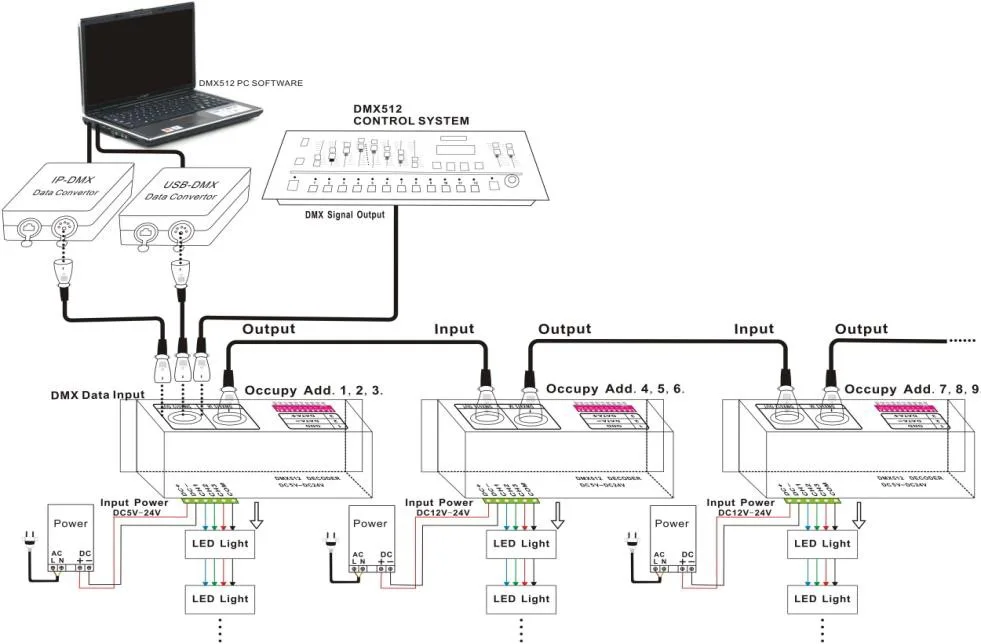
DMX512 제어 장치 선택
I. DMX512 마스터
DMX512 마스터는 국제 표준 DMX512/1990의 신호를 DMX512 디코더로 출력하여 희미한 단일 컬러, 듀얼 컬러 CCT, RGB, RGBW 및 RGB+CCT LED 조명을 제어합니다. 가장 일반적으로 사용되는 두 가지는 다음과 같습니다:
1. DMX512 터치 패널 컨트롤러: 디밍, 색온도 조정, RGB/RGBW 제어 기능, 구역 관리 기능(최대 4개 구역)이 내장된 DMX512 출력을 지원하며 여러 동적 모드(그라데이션 및 점프 등)가 통합되어 있습니다. 86형 설치 디자인은 상업용 또는 가정용 시나리오에 적합합니다.
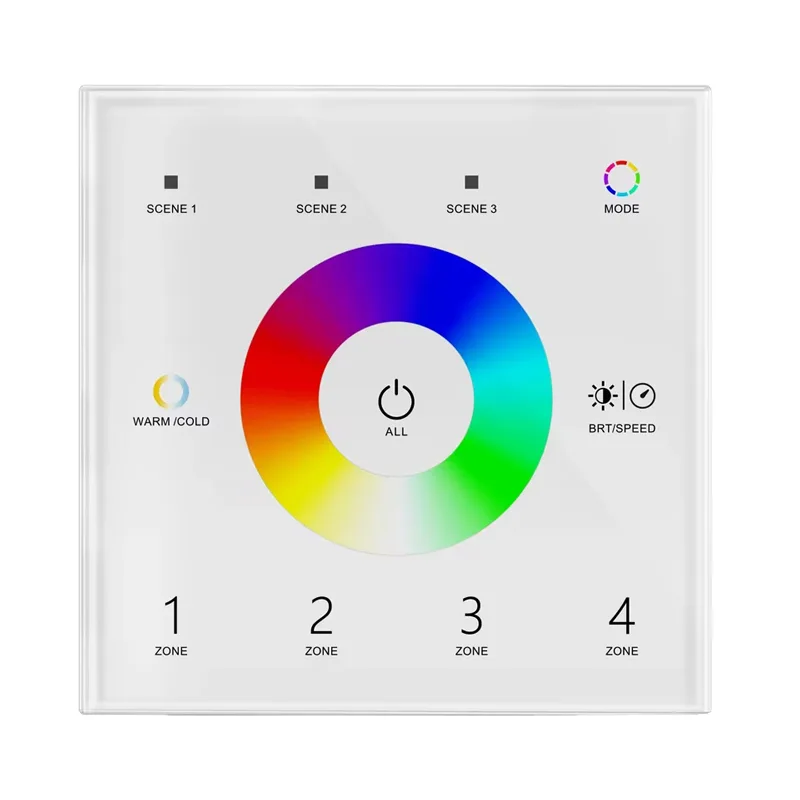
T15 벽면 장착형 DMX512 터치 패널
터치 패널 4존 1-5 컬러 DMX512 마스터는 4존 1-5 컬러 RF 리모컨으로도 사용할 수 있습니다.
표준 DMX512 프로토콜을 준수하는 DMX 신호 출력으로 모든 공급업체의 DMX 디코더와 호환됩니다.
RF 리모컨으로 사용할 경우 각 구역에서 여러 개의 RF 2.4G LED 컨트롤러, 디밍 드라이버 또는 스마트 램프를 원격으로 제어할 수 있습니다.
● 매우 민감하고 강도가 높습니다.
T15 벽면 장착형 DMX512 터치 패널 데이터시트 다운로드
가격: 24.98 USD/개
2. DMX512 컨트롤r: DMX512 컨트롤러는 무대 조명 및 건축 조명 특수 효과 장비의 중앙 집중식 조절 및 제어에 사용되는 핵심 장치입니다. DMX512 프로토콜을 기반으로 디지털 신호를 통해 명령을 전송합니다. 램프, 모터 등 여러 장치를 동시에 관리하고 밝기, 색상, 동적 효과 등의 파라미터를 정밀하게 조정하며 독립된 주소를 통해 각 장치에 해당하는 채널 데이터를 식별할 수 있습니다. 사전 설정 장면 프로그래밍 또는 실시간 제어를 지원하여 조명 변경의 동기화 및 자동화를 달성할 수 있습니다.
K-1000C와 K-8000C는 오프라인 제어에 적합합니다. 단일 유닛으로 사용하거나 여러 캐스케이드에 연결하여 더 많은 LED 픽셀을 구동할 수 있습니다.
a. 메인 램프가 80,000픽셀 미만인 경우 K-1000C DMX 픽셀 컨트롤러를 사용하는 것이 좋습니다.
b. 메인 램프가 8,000~20,000픽셀인 경우 K-8000C DMX LED 픽셀 컨트롤러를 사용하는 것이 좋습니다.

II. DMX-SPI 디코더
DMX512 신호를 LED 조명 스트립에서 인식할 수 있는 프로토콜(예: SPI)로 변환합니다. 예를 들어 TM1803 및 UCS512와 같은 칩이 사용되며, 각 칩은 하나 이상의 LED 픽셀의 RGB 채널 제어에 해당합니다.
각 LED 픽셀에는 독립적인 주소 코드가 할당되어야 하며, 채널 매핑을 통해 포인트별 제어가 이루어집니다(예: RGB 픽셀은 3개의 DMX 채널을 사용).
DMX 콘솔로 제어할 수 있으며, 여러 대의 DMX 디코더를 연결하여 출력을 높이고 모든 기능을 구현할 수 있습니다. 다양한 모드 변경. 또한 DMX 디코더는 싱크로나이저로도 사용할 수 있습니다. 컨트롤러는 LED를 별도로 제어하여 동기화 효과를 얻을 수 있습니다.
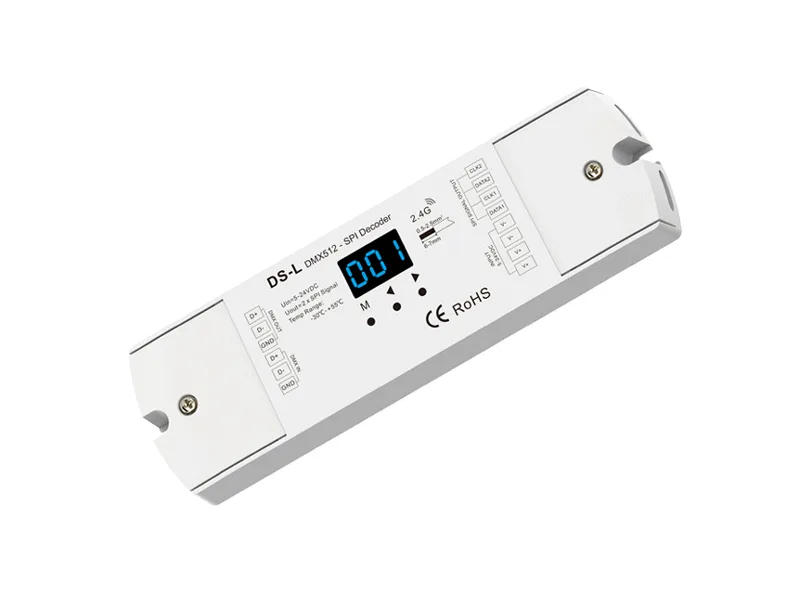
DMX - SPI RGB RGBW 디코더 및 RF 컨트롤러
모델: CTL-RGB-DMX-DS-L
공급 전압: DC5V~24V
전력 소비량: 1W
입력 신호: DMX512 + RF 2.4GHz
출력 신호: SPI(TTL) x 3/4채널
동적 모드: 32
컨트롤 도트: 170픽셀(RGB 510채널), 최대 900픽셀
치수: L175 x W54 x H27mm
가격: 16.98 USD/개
III. 방수 LED 네온 스트립용 DMX 신호 증폭기 DA
DMX 신호의 전송 거리를 연장하는 데 사용되며, 1개의 입력과 다수의 출력을 지원합니다. 광전 절연 기술을 통해 신호 안정성을 향상시키며 장거리 또는 복잡한 전자기 환경에 적합합니다.
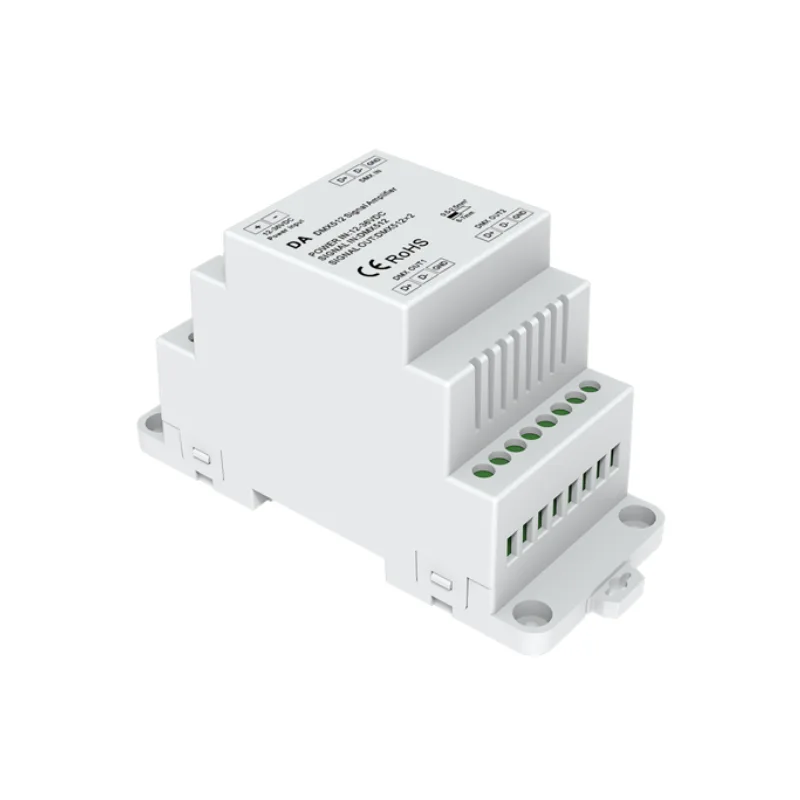
DA DMX 신호 증폭기
2채널 DMX 512 신호 증폭기.
1개의 DMX512 신호 입력, 2개의 DMX512 신호 출력. DMX512(또는 RS-485) 버스에 연결될 때 DMX 조명 시스템 장비에서 나오는 신호를 증폭, 분배 및 절연하는 전용 제품입니다.
신호 전송 거리 확장을 실현합니다.
신호 확장 출력 제어; 멀티 채널 제어를 분산하기 위해 DMX(485) 신호 증폭기를 늘립니다.
가격: 24.98 USD/개
전원 공급 장치를 구성하는 방법은 무엇인가요?
DMX512 LED 네온 스트립 시스템은 일반적으로 여러 개의 조명 세그먼트로 구성되며, 총 부하 전력과 동적 변화에 따라 여유를 확보해야 합니다.
1. 총 부하 전력 계산: P 합계 = ∑ (단일 조명 섹션 전력 × 수)
단일 조명 섹션 전력: 미터당 또는 섹션당 DMX512 LED 네온 스트립 전력(예: 5W/m).
예시: 라이트 테이프는 10개의 섹션으로 구성되어 있으며, 각 섹션은 3미터이고 미터당 전력은 8W입니다. 총 = 10 × 3 × 8 = 240W
2. 전원 공급 장치 정격 전력 계산전력 = P 총계 × (1 + 안전 계수) ÷ 전력 효율 + P(DMX 컨트롤러)
안전 계수: 0.2~0.3을 권장합니다(DMX 시스템은 디밍 및 전류 변동이 잦을 수 있음).
전력 효율: 일반적으로 85%~95%(스위칭 전원 공급 장치가 더 효율적임).
DMX 컨트롤러 전력 소비량: 일반적으로 5~20W(특정 모델을 참조해야 함).
예시:
총 부하 240W, 안전율 0.3, 전원 공급 장치 효율 90%, 컨트롤러 전력 소비 15W:
전원 공급 장치 = 240X1.3÷0.9+15≈303+15=362W
360W 이상의 전원 공급 장치를 선택해야 합니다.
브랜드 전원 공급 장치 신호 간섭 및 전압 강하 문제를 최소화하기 위해 (예: Mean Well XLG 시리즈) 사용하는 것이 좋습니다. 라이트 바의 전원에 맞는 안정적인 전압(일반적으로 DC12V 또는 24V)을 제공합니다(예: 12W/m@RGB).
전압 강하란 무엇인가요?
간단히 말해, 전압 강하 는 전류가 LED 조명기구를 통과할 때 회로에서 전압이 흐르는 동안 발생하는 에너지 손실입니다. 이 과정은 좁은 파이프를 통과하는 물의 흐름과 유사하며, 물의 속도는 마찰로 인해 일정량의 에너지 손실이 발생합니다. LED 램프와 랜턴의 경우 전압 강하는 전력 출력 부족으로 이어져 램프와 랜턴의 발광 효율과 수명에 영향을 미칩니다.
LED 스트립 전압 강하 문제는 LED 스트립이 전원 공급 장치에 연결될 때 회로의 길이와 전압 손실로 인한 작은 전류로 인해 LED 스트립 밝기가 충분하지 않거나 고르지 않은 경우입니다. 이 문제는 LED 조명 스트립을 오랫동안 사용해 온 사용자에게는 매우 까다로운 문제이므로 해결책을 찾아야 합니다!
LED 조명 스트립 전압 강하 원인:
- 더 작은 전류LED 스트립 조명의 전류는 일반적으로 0.02~0.03A로 작기 때문에 단선에서도 전압 손실이 발생하며 장선 애플리케이션에서 더 두드러집니다.
- 라인 길이: 일반적으로 드라이버와 LED 스트립 조명 스트립 사이의 선 길이가 길수록 전압 강하 문제가 더 분명해집니다.
- 품질 문제: LED 스트립의 품질도 전압 강하 문제에 영향을 미칠 수 있습니다. 일부 저품질 LED 스트립은 내부 저항이 과도하거나 불충분하여 전압 강하 문제가 발생할 수 있으며, 이로 인해 라인 저항이 증가할 수 있습니다.
LED 네온 스트립 설치용 전선을 선택하는 방법은 무엇인가요?
DMX512 시스템 저전압 전원 공급 장치(12V/24V DC), 라인 전류가 크고 전압 강하 문제가 특히 두드러지므로 최종 전압이 안정적인지 확인해야 합니다.
램프 비드 전후의 발광 밝기의 일관성을 보장하고 라이트 스트립에 대한 전압 강하의 영향을 피하기 위해 일반적으로 다음과 같은 방법을 사용할 수 있습니다:
전선 직경 증가: 선로 저항 감소(일반 전선 직경: 1.5mm², 2.5mm²).
● 분할 전원 공급 장치: 장거리 배선 시 전원 공급 장치를 여러 회로로 분할하세요.
전원 공급 장치 전압 업그레이드: 끝단의 전압 강하가 너무 크면 약간 더 높은 전압의 전원 공급 장치를 사용하세요(예: 12V 대신 24V 시스템 설계).
전압 강하를 올바르게 처리하고 전선 직경을 늘리기 위해 도체에 의존하지 않으려면 비용 증가와 배선의 합리성을 고려해야 합니다. 전압 강하 문제를 추가로 보완하기 위해 다음 단계를 올바르게 선택할 수 있습니다.
1단계. 탭 전류 계산하기
DMX 시스템은 일반적으로 여러 개의 제어 회로로 나뉘며, 각 부하 회로에 대해 개별적으로 계산해야 합니다:
I 싱글 = P 싱글 / V 작업
예: 스트립 3개 섹션의 단일 부하(3m × 8W/m × 3개 섹션 = 72W), 작동 전압은 24V입니다.
I 단일 회로 = 72/24 = 3.0A
2단계: 전압 강하 계산
R=ρ×(2L/A)
ΔU=I 단일 회로×R 라인
주요 매개 변수:
ρ: 구리선 저항을 0.0172 Ω-mm²/m로 간주합니다.
L: 전원 공급 장치에서 끝까지의 단방향 거리(단위: 미터).
A: 와이어의 단면적(단위: mm²).
2L: 현재 왕복 경로의 총 길이는 2L입니다.
예시:
단일 회로 전류 3A, 회선 단방향 길이 15미터, 1.5mm² 구리선 사용:
R = 0.0172 x (2 x 15/1.5) = 0.344 Ω
전압 강하: ΔU=3AX0.344Ω≈1.032VV
최종 전압: 24V-1.032V=22.97V(4.29%의 전압 강하, ≤5% 요건에 부합).
허용 전압 강하: 일반적으로 작동 전압의 5%-10%를 초과하지 않아야 합니다(12V 시스템 전압 강하 ≤ 0.6-1.2V, 24V 시스템 ≤ 1.2-2.4V).
주의 사항:
1. 신호와 전원 공급 장치 분리: 독립적인 전원 공급 장치를 사용하는 것이 좋습니다. DMX 컨트롤러와 LED 조명 스트립은 간섭을 피하기 위해 독립적인 전원 공급 장치를 사용하는 것이 좋습니다.
2. 차폐선: DMX 신호선은 꼬인 차폐선(예: CAT5e)을 사용해야 하며 전원선으로부터 30cm 이상 거리를 유지해야 합니다.
3. 세분화된 전원 공급 전략: 장거리에 설치하는 경우 20~30미터마다 전원 지점을 설정하여 단일 회로 전압 강하를 줄이세요.
4. 전원 동기화: 여러 개의 전원 공급 장치를 병렬로 연결할 때는 공통 접지를 확보하거나 동기화 모듈을 사용하여 전위차가 DMX 신호에 간섭하지 않도록 하세요.
5. 최종 전압 측정: 멀티미터를 사용하여 최종 전압이 정격 전압의 90% 이상인지 확인합니다.
6. 신호 안정성 테스트: 전원 간섭으로 인해 DMX 신호가 깜빡이거나 패킷이 손실되는지 확인합니다.
7. 온도 상승 테스트: 1시간 동안 최대 부하로 작동한 후 전원 공급 장치의 표면 온도는 ≤60℃가 되어야 합니다.
실외 설치에 대해서는 해당 게시물을 참조하세요: 건축가 및 설치자를 위한 실외 LED 네온 플렉스 마운팅 솔루션.
요약
DMX 제어 LED N이온 플렉스 는 표준화된 프로토콜과 높은 간섭 방지 기능 덕분에 건축 조명 프로젝트에 이상적인 선택이 되었습니다.
이 기술은 DMX512 프로토콜을 통해 정밀한 조명 제어를 실현하고 장거리 신호 전송(최대 수백 미터) 및 다중 노드 동기화를 지원하며 밝기, 색상 및 동적 효과를 유연하게 조정할 수 있어 건물 외관 장식, 경관 조명 및 기타 시나리오에 적합합니다.
차동 신호 전송 기술을 채택하여 전자기 간섭을 효과적으로 방지하고 중단점 전송 기능을 지원하여 시스템 안정성을 향상시킵니다. 실제 애플리케이션은 DMX512 주소 편집기를 사용하여 램프와 랜턴의 주소를 구성하고 컨트롤러(예: Interact IoT 플랫폼)를 통해 중앙 집중식 관리를 달성하고 에너지 소비 및 유지 관리 효율성을 최적화하는 등 주소 설정 및 라인 계획에 주의를 기울여야 합니다.
지능형 디밍 및 구역 제어와 결합된 DMX512 LED 네온 조명 시스템은 합리적인 설계를 통해 정밀한 제어와 균일한 밝기를 실현하는 동시에 장기간 안정적인 작동을 보장합니다.
